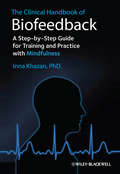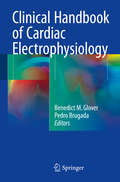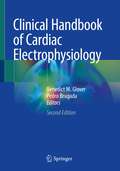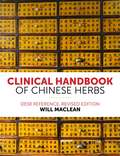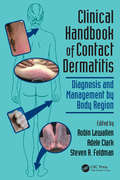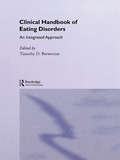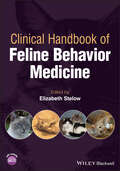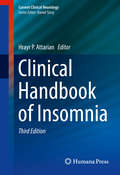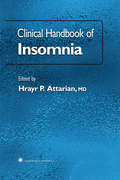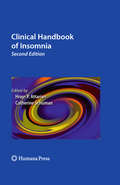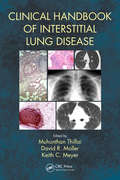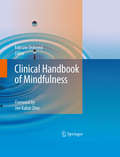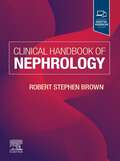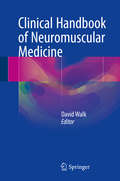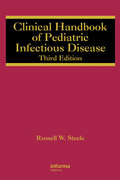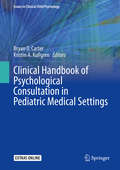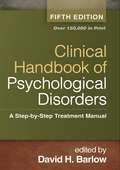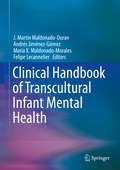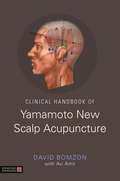- Table View
- List View
The Clinical Handbook of Biofeedback: A Step-by-Step Guide for Training and Practice with Mindfulness
by Inna Z. KhazanA practical guide to the clinical use of biofeedback, integrating powerful mindfulness techniques. A definitive desk reference for the use of peripheral biofeedback techniques in psychotherapeutic settings, backed by a wealth of clinical research Introduces mindfulness and acceptance techniques and shows how these methods can be incorporated into biofeedback practice Step-by-step instructions provide everything a clinician needs to integrate biofeedback and mindfulness including protocols, exemplar logs for tracking symptoms, and sample scripts for mindfulness exercises Includes scientifically robust treatment protocols for a range of common problems including headaches, hypertension and chronic pain
The Clinical Handbook of Biofeedback: A Step-by-Step Guide for Training and Practice with Mindfulness
by Inna Z. KhazanA practical guide to the clinical use of biofeedback, integrating powerful mindfulness techniques. A definitive desk reference for the use of peripheral biofeedback techniques in psychotherapeutic settings, backed by a wealth of clinical research Introduces mindfulness and acceptance techniques and shows how these methods can be incorporated into biofeedback practice Step-by-step instructions provide everything a clinician needs to integrate biofeedback and mindfulness including protocols, exemplar logs for tracking symptoms, and sample scripts for mindfulness exercises Includes scientifically robust treatment protocols for a range of common problems including headaches, hypertension and chronic pain
Clinical Handbook of Cardiac Electrophysiology
by Benedict M. Glover Pedro BrugadaThis book provides a detailed summary of all aspects of cardiac electrophysiology, presented in an easy to use handbook. For each arrhythmia the aetiology, classification, clinical presentation, mechanism, and electrophysiology is set up (including precise set up and ablation parameters) and trouble-shooting are presented and demonstrated using interesting images, fluoroscopy images, ECG’s and electrograms.The overall aim of this book is to provide a logical and practical approach to cardiac arrhythmia management. It acts as a useful resource and, importantly, helps to promote this sub-specialty. This book is aimed at cardiac electrophysiologist’s, fellows, cardiologists, physicians, family practitioners, cardiology trainees, students, allied professionals and nurses. Given its succinct summary of electrophysiology is a useful reference guide for the electrophysiology laboratory. It is aimed at an international audience and provides an important guide for those studying for all heart rhythm exams.
Clinical Handbook of Cardiac Electrophysiology
by Benedict M. Glover Pedro BrugadaThis extensively revised second edition provides a practically applicable guide for the management of cardiac arrhythmia. This subject has continued to expand rapidly, and it is therefore critical to understand the basic principles of arrhythmia mechanisms in order to assist with diagnosis and the selection of an appropriate treatment strategy. Comprehensively revised chapters cover a variety of aspects of cardiac electrophysiology in an easy-to-digest case-based format. For each case of arrhythmia, relevant illustrations, fluoroscopy images, ECGs and endocavity electrograms are used to describe the etiology, classification, clinical presentation, mechanisms, electrophysiology set up and relevant trouble-shooting procedures. New topics covered include the application of new antiarrhythmic drugs in tandem with ablation, techniques for the ablation of atrial fibrillation and electrophysiological assessments available for identifying instances of atrial tachycardia. Clinical Handbook of Cardiac Electrophysiology presents a comprehensive overview of cardiac electrophysiology, making it a valuable reference for practicing and trainee cardiac electrophysiologists, cardiologists, family practitioners, allied professionals and nurses.
Clinical Handbook of Chinese Herbs: Desk Reference, Revised Edition
by Will MacleanThis revised edition of Maclean's classic Clinical Handbook of Chinese Herbs is an extensive and detailed guide to the medicinal properties of traditional Chinese herbs, and how they should be prescribed in today's medical practice. The handbook employs comparative charts to help clinicians to select the optimal medicinals for their patients. Each table outlines the characteristics of a group of herbs, including extensive indications with relative strengths of action and function, the domain, flavour, nature, and dosage guidelines. The book also caters for special circumstances in health that may alter a patient's requirements, with appendices giving need-to-know instructions for a number of specific cases. Easy-to-use and comprehensive, the handbook will facilitate efficient comparative reference, as well as detailing the fine points of discrimination.
Clinical Handbook of Chinese Herbs: Desk Reference, Revised Edition (PDF)
by Will MacleanThis revised edition of Maclean's classic Clinical Handbook of Chinese Herbs is an extensive and detailed guide to the medicinal properties of traditional Chinese herbs, and how they should be prescribed in today's medical practice. The handbook employs comparative charts to help clinicians to select the optimal medicinals for their patients. Each table outlines the characteristics of a group of herbs, including extensive indications with relative strengths of action and function, the domain, flavour, nature, and dosage guidelines. The book also caters for special circumstances in health that may alter a patient's requirements, with appendices giving need-to-know instructions for a number of specific cases. Easy-to-use and comprehensive, the handbook will facilitate efficient comparative reference, as well as detailing the fine points of discrimination.
Clinical Handbook of Contact Dermatitis: Diagnosis and Management by Body Region
by Robin Lewallen Adele Clark Steven R. FeldmanThe Clinical Handbook of Contact Dermatitis: Diagnosis and Management by Body Region uses a succinct approach to help clinicians manage this multifaceted condition. Organized by body region, the handbook presents the most common allergens and irritants for a given location. It discusses products containing common allergens and irritants such as top
Clinical Handbook of Contact Dermatitis: Diagnosis and Management by Body Region
by Robin Lewallen Adele Clark Steven R. FeldmanThe Clinical Handbook of Contact Dermatitis: Diagnosis and Management by Body Region uses a succinct approach to help clinicians manage this multifaceted condition. Organized by body region, the handbook presents the most common allergens and irritants for a given location. It discusses products containing common allergens and irritants such as top
Clinical Handbook of Eating Disorders: An Integrated Approach
by Timothy D. BrewertonEmphasizing that accurate diagnosis is the foundation for effective treatment regimens, this reference reviews the most current research on the assessment, epidemiology, etiology, risk factors, neurodevelopment, course of illness, and various empirically-based evaluation and treatment approaches relating to eating disorders-studying disordered eati
Clinical Handbook of Eating Disorders: An Integrated Approach (Medical Psychiatry Ser. #Vol. 26)
by Timothy D. BrewertonEmphasizing that accurate diagnosis is the foundation for effective treatment regimens, this reference reviews the most current research on the assessment, epidemiology, etiology, risk factors, neurodevelopment, course of illness, and various empirically-based evaluation and treatment approaches relating to eating disorders-studying disordered eati
Clinical Handbook of Feline Behavior Medicine
by Elizabeth StelowClinical Handbook of Feline Behavior Medicine Comprehensive resource offering practical and accessible guidance on managing behavior problems in cats Clinical Handbook of Feline Behavior Medicine provides a complete, easy-to-use reference to practical information on identifying, diagnosing, and treating behavior problems in cats. Designed to offer streamlined access to concrete guidance for managing feline behavior, the book offers diagnostic plans organized by clinical sign. Normal behavior is thoroughly described, to provide a better understanding of the abnormal, with the heart of the book devoted to advice for identifying, diagnosing, and treating specific behavior problems. The book describes the diagnostic process and covers treatment options for each problem. A companion website offers client education handouts to enhance compliance and video clips depicting presenting complaints. Sample topics covered in Clinical Handbook of Feline Behavior Medicine include: Normal feline social behavior, covering body language and other social communication, feline social structure, interactions with humans and other species, and social/behavioral development in the kitten Preventing behavior problems, covering feeding, litter box availability and care, scratching options, toys, and grooming Elimination problems, including the differentiation between urine marking and toileting, deducing the underlying causes, and elements of effects treatment plans Senior cats, covering feline cognitive decline, increased vocalization, sleep-wake cycle disturbances, disorientation, litterbox problems, and repetitive behaviors With its specific topical focus of behavior in felines, Clinical Handbook of Feline Behavior Medicine is a targeted and highly useful resource for any veterinarian seeing feline patients, assisting through all stages of treatment with easily accessible and understandable information.
Clinical Handbook of Feline Behavior Medicine
by Elizabeth StelowClinical Handbook of Feline Behavior Medicine Comprehensive resource offering practical and accessible guidance on managing behavior problems in cats Clinical Handbook of Feline Behavior Medicine provides a complete, easy-to-use reference to practical information on identifying, diagnosing, and treating behavior problems in cats. Designed to offer streamlined access to concrete guidance for managing feline behavior, the book offers diagnostic plans organized by clinical sign. Normal behavior is thoroughly described, to provide a better understanding of the abnormal, with the heart of the book devoted to advice for identifying, diagnosing, and treating specific behavior problems. The book describes the diagnostic process and covers treatment options for each problem. A companion website offers client education handouts to enhance compliance and video clips depicting presenting complaints. Sample topics covered in Clinical Handbook of Feline Behavior Medicine include: Normal feline social behavior, covering body language and other social communication, feline social structure, interactions with humans and other species, and social/behavioral development in the kitten Preventing behavior problems, covering feeding, litter box availability and care, scratching options, toys, and grooming Elimination problems, including the differentiation between urine marking and toileting, deducing the underlying causes, and elements of effects treatment plans Senior cats, covering feline cognitive decline, increased vocalization, sleep-wake cycle disturbances, disorientation, litterbox problems, and repetitive behaviors With its specific topical focus of behavior in felines, Clinical Handbook of Feline Behavior Medicine is a targeted and highly useful resource for any veterinarian seeing feline patients, assisting through all stages of treatment with easily accessible and understandable information.
Clinical Handbook of Insomnia (Current Clinical Neurology)
by Hrayr P. AttarianExpanding on the critical contributions of previous editions, this updated and comprehensive resource covers the latest diagnostic criteria of insomnia. The book is thematically divided into two parts. The first section consists of chapters on nomenclature, epidemiology, pathophysiology, diagnosis and differential diagnosis, complications and prognosis and treatment both pharmacological and behavioral. The second features chapters on insomnia in special populations, including ones on children and adolescents, cancer sufferers and survivors, in pregnancy, in menopausal women and in patients with neurological disorders and those with psychiatric illnesses. This third edition fills an important niche in the medical literature by addressing insomnia in its multiple forms, summarizes the findings published in different medical journals, and presents these to the practicing health care provider in an easily accessible format.
Clinical Handbook of Insomnia (Current Clinical Neurology)
by Hrayr P. AttarianExpert clinicians and researchers provide practicing primary health care providers the first clinically oriented, comprehensive textbook devoted to the evaluation and treatment of insomnia. Summarizing the latest findings published in a wide variety of medical journals, these experts concisely review the primary insomnias and those due to medical, neurological, and psychiatric problems, and to fully discuss the latest pharmacological and nonpharmacological treatments for insomnia. A simple algorithm for the differential diagnosis of insomnia is included.
Clinical Handbook of Insomnia: Scientific And Clinical Aspects (Current Clinical Neurology)
by Hrayr P. Attarian Catherine SchumanIt has been 5 years since publication of the first edition of Dr. Attarian’s Clinical Handbook of Insomnia which at the time was the first significant cl- ical textbook dedicated to insomnia, an often overlooked but important me- cal problem. The book was very well received. There has now been sufficient new information on the subject to warrant a second expanded edition of this very useful volume. Then, as now, the approach is to emphasize the frequent biological causes of insomnia rather than to attribute it primarily to underlying psychological and emotional factors. This new edition is an impressive major effort, having been expanded from 14 to 23 chapters including an extensive revision and updating of previous chapters with new references and the ad- tion of many new authors. An entirely new section of the book deals with insomnia in special populations including teenagers, pregnancy, menopause, and the geriatric population. Other new topics include insomnia as enco- tered in primary care practice, the role of circadian rhythms, the contribution of sleep related movement disorders to insomnia, insomnia in pain disorders, and the interesting entity of paradoxical insomnia, in which there is a large d- crepancy between the objective and subjective estimation of quantity of sleep. This collection within a single volume of practical information concerning a common but often neglected disorder remains a very useful addition to the armamentarium of the general or specialty physician who wishes to properly address insomnia in an informed and responsible manner.
Clinical Handbook of Interstitial Lung Disease
by Keith C. Meyer Muhunthan Thillai David R. MollerThis handbook provides clinical guidance to the practicing physician on the diagnosis and treatment of Interstitial Lung Diseases (ILD). A contributed work with invited chapters which draw on the knowledge and experience of recognised global leaders in respiratory medicine, it is authoritative, concise and portable and is intended for use in a fast-paced clinical setting. The book: offers practical tips and clear guidance for clinicians provides detailed explanations of the main therapeutic options for each individual ILD contains high-quality visuals, including radiology and histopathology of the most common as well as some of the rarer ILDs discusses individual ILDs and has topics common to all including critical care, lung transplantation and palliative care navigates clinicians through cases with decision making guidelines and algorithms includes appendices with international practice guidelines, sample patient information sheets and other helpful resources. Emphasizing how to perform a thorough assessment of an ILD patient for accurate diagnosis and their subsequent effective management, this is both a gold standard text as well as a daily companion for physicians caring for ILD patients. A first-of-its-kind, it will become the go-to guide for all clinicians who manage patients with ILD.
Clinical Handbook of Interstitial Lung Disease
by Muhunthan Thillai, David R Moller and Keith C MeyerThis handbook provides clinical guidance to the practicing physician on the diagnosis and treatment of Interstitial Lung Diseases (ILD). A contributed work with invited chapters which draw on the knowledge and experience of recognised global leaders in respiratory medicine, it is authoritative, concise and portable and is intended for use in a fast-paced clinical setting. The book: offers practical tips and clear guidance for clinicians provides detailed explanations of the main therapeutic options for each individual ILD contains high-quality visuals, including radiology and histopathology of the most common as well as some of the rarer ILDs discusses individual ILDs and has topics common to all including critical care, lung transplantation and palliative care navigates clinicians through cases with decision making guidelines and algorithms includes appendices with international practice guidelines, sample patient information sheets and other helpful resources. Emphasizing how to perform a thorough assessment of an ILD patient for accurate diagnosis and their subsequent effective management, this is both a gold standard text as well as a daily companion for physicians caring for ILD patients. A first-of-its-kind, it will become the go-to guide for all clinicians who manage patients with ILD.
Clinical Handbook of Mindfulness
by Fabrizio DidonnaOver the last two decades, Eastern psychology has provided fertile ground for therapists, as a cornerstone, a component, or an adjunct of their work. In particular, research studies are identifying the Buddhist practice of mindfulness—a non-judgmental self-observation that promotes personal awareness—as a basis for effective interventions for a variety of disorders. The Clinical Handbook of Mindfulness is a clearly written, theory-to-practice guide to this powerful therapeutic approach (and related concepts in meditation, acceptance, and compassion) and its potential for treating a range of frequently encountered psychological problems. Key features of the Handbook: A neurobiological review of how mindfulness works. Strategies for engaging patients in practicing mindfulness. Tools and techniques for assessing mindfulness. Interventions for high-profile conditions, including depression, anxiety, trauma Special chapters on using mindfulness in oncology and chronic pain. Interventions specific to children and elders, Unique applications to inpatient settings. Issues in professional training. Appendix of exercises. The Clinical Handbook of Mindfulness includes the contributions of some of the most important authors and researchers in the field of mindfulness-based interventions. It will have wide appeal among clinicians, researchers, and scholars in mental health, and its potential for application makes it an excellent reference for students and trainees.
Clinical Handbook of Nephrology - E-Book
by Robert S. BrownConcise and easy to navigate, Clinical Handbook of Nephrology contains vital, everyday information on renal physiology and a wide range of topics, including diagnosis and treatment of acute and chronic kidney diseases, hypertension, electrolyte and acid-base disorders, dialysis, and kidney transplantation. This fully up-to-date reference (formerly Nephrology Pocket, a textbook originally published by Börm Bruckmeier) is ideal for physicians, nurses, dialysis center staff, medical students, and trainees, offering a practical roadmap for managing the renal disorders most likely to be encountered in clinical practice. Contains dozens of diagnostic and treatment algorithms, tables, and charts that allow you to find answers quickly and easily at the point of care. Allows you to easily find protocols, drug information and treatment guidelines, including the latest KDIGO (Kidney Disease Improving Global Outcomes) for the evaluation and management of chronic kidney disease, glomerulonephritis, and blood pressure management. Provides sections on symptoms, signs, and differential diagnoses that allow you to quickly identify common differentials. Features dedicated chapters on kidney stones, dialysis, and kidney transplantation. Includes common labs useful for ruling out other medical causes of renal disorders.
Clinical Handbook of Neuromuscular Medicine
by David WalkThis concise and practical book provides an overview of neuromuscular disorders in clinical practice. Diagnostic approaches are covered along with patient management strategies in an easy-to-understand and introductory framework. Filling a significant gap in the literature, this resource delivers essential information for neurology trainees and practitioners, as well as anyone interested in learning the fundamentals of this important medical subspecialty.
Clinical Handbook of Pediatric Infectious Disease
by Russell W. SteeleIn the care of pediatric patients, infectious diseases comprise over 50% of the clinical diagnoses. For this reason, it is essential to have a basic understanding of infectious processes and to keep abreast of new developments in the field. This reference stands as a convenient and time-saving reference for clinicians on the diagnosis, treatment, a
Clinical Handbook of Psychological Consultation in Pediatric Medical Settings (Issues in Clinical Child Psychology)
by Bryan D. Carter Kristin A. KullgrenThis handbook examines pediatric consultation-liaison psychology in pediatric medical settings. It offers a brief history of pediatric psychologists’ delivery of consultation-liaison services. The handbook provides an overview of roles, models, and configurations of pediatric psychology practice in diverse inpatient and outpatient medical settings. Chapters discuss the most frequently seen major pediatric conditions encountered in consultation practice. Coverage includes evaluation, intervention, and treatment of each condition. Each clinical condition addresses the referral problem in the context of history and family dynamics. In addition, chapters address important aspects of the management of a consultation-liaison service and provide contextual issues in delivering evidence-based services in hospital and medical settings. Topics featured in this handbook include:The role of assessment in the often fast-paced medical environment.Modifications of approaches in the context of disorders of development.Consultation on pediatric gender identity.The presentation of child maltreatment in healthcare settings.The use of technological innovations in pediatric psychological consultation.Important ethical considerations in consultation-liaison practice. Clinical Handbook of Psychological Consultation in Pediatric Medical Settings is a must-have resource for clinicians and related professionals as well as researchers, professors, and graduate students in pediatric and clinical child and adolescent psychology, pediatrics, social work, developmental psychology, child and adolescent psychiatry, and related disciplines.
Clinical Handbook Of Psychological Disorders, (5th Edition) (PDF): A Step-by-step Treatment Manual
by David H. BarlowThis clinical reference and widely adopted text is recognized as the premier guide to understanding and treating frequently encountered psychological disorders in adults. Showcasing evidence-based psychotherapy models, the volume addresses the most pressing question asked by students and practitioners--"How do I do it?" Leading authorities present state-of-the-art information on each clinical problem, explain the conceptual and empirical bases of their respective approaches, and show what the techniques look like in action. Extended case examples with session transcripts illustrate each component of treatment. New to This Edition *Incorporates treatment innovations, the latest empirical findings, and changes to diagnostic criteria in DSM-5. *Chapter on acceptance-based treatment of generalized anxiety disorder. *Chapter on comorbid depression and substance abuse, demonstrating a transdiagnostic approach. *Chapter on sleep disorders. See also Handbook of Assessment and Treatment Planning for Psychological Disorders, Third Edition, edited by Martin M. Antony and David H. Barlow, and Clinical Handbook of Psychological Disorders in Children and Adolescents, edited by Christopher A. Flessner and John C. Piacentini.
Clinical Handbook of Transcultural Infant Mental Health
by Felipe Lecannelier J. Martin Maldonado-Duran Andrés Jiménez-Gómez Maria X. Maldonado-MoralesThis handbook provides a review of relevant topics concerning the interface between culture and mental health, with a particular focus on child-rearing practices and transcultural issues in the perinatal period, infancy, and early childhood. It discusses how to work with infants and families from diverse backgrounds and addresses the most common issues that medical and mental health experts may encounter when working with individuals from other cultures. Chapters examine the considerable range of child-rearing strategies and how families from various cultural groups approach issues such as infant sleep, feeding practices, and care during pregnancy. In addition, chapters address conditions that are seen mostly within a particular sociocultural context and are “culture bound” syndromes or states. The handbook concludes with the editors’ recommendations for future research directions. Topics featured in this handbook include:Prejudice, discrimination, and stereotyping within the clinical field.Cultural responses to infant crying and irritability.Cultural issues in response to chronic conditions and malformations in infancy.The healthy immigrant effect.The use of folk and traditionally therapeutic remedies. The Clinical Handbook of Transcultural Infant Mental Health is an essential resource for researchers, clinicians and related professionals, and graduate students in infancy and early child development, child and school psychology, pediatrics, social work, obstetrics, and nursing.
Clinical Handbook of Yamamoto New Scalp Acupuncture
by David BomzonThis handbook is an invaluable resource on the principles and practice of Yamamoto New Scalp Acupuncture (YNSA). This popular form of scalp acupuncture is used to treat a wealth of neurological conditions, and is very effective in stroke patients with pain and restricted mobility, providing relief from the symptoms. David Bomzon is an international expert on YNSA and he includes step-by-step explanations of points, points location, indications for needling, and clinical cases, all supported by line drawings and photographs. Uniquely, this book is written by an acupuncturist for acupuncturists, chiropractors and physical therapists, and the author clearly reconciles the theoretical needling points described by Yamamoto with actual needling points. Basic, sensory, brain, Y (epsilon) and cranial points are all covered, as well as instructions on applying YNSA in the clinic. The handbook also explains the benefits of combining YNSA treatment with Western medicine and physical therapy, making this essential reading for all practitioners looking to expand their knowledge of scalp acupuncture.
